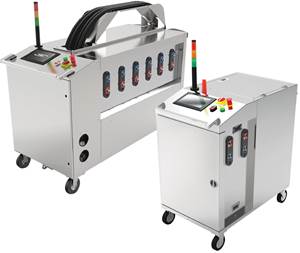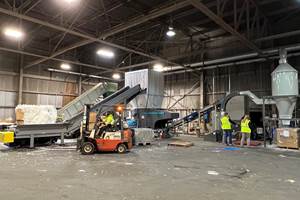Molder Pushes Limits of Rapid Tooling in Coronavirus Crash Projects
Harbec explores 3D printed aluminum molds with conformal cooling.
Injection molders have probably all encountered customers that demand projects to be executed with impossibly short lead times. But an entirely different sense of urgency has galvanized plastics processors to devote every resource and stretch their capabilities to meet the need for protective masks and testing devices in the global battle against the novel coronavirus. One such molder is Harbec, Inc. in Ontario, N.Y., which relied on both its molding skills and moldmaking expertise to beat the clock in three COVID-19 related projects—and in the process accomplish new feats with 3D-printed tooling.
Harbec is a custom injection molder and moldmaker with additional metalworking business in aluminum aircraft parts and titanium surgical implants. “We started out as a machine shop,” notes company president Bob Bechtold, “and got into molding to give our tooling customers more confidence in our know-how.”
Despite the added tensions of wearing masks, limiting visitors, and testing body temperature at every plant entrance, Harbec hasn’t missed any work days or suffered lost productivity since the pandemic struck, says Bechtold. “It’s an unnerving time, but the opportunity to help meet urgent needs is the thing that has kept us going. Everyone here rallied around, and it became important to go to work.”

Coronavirus antibody test device was taken from a CAD model through mold design and build and injection molding in 72 hr, and approved sample parts in 96 hr. (Photo: Drummond Scientific Co.)
Project 1: Antibody Test units
One of Harbec’s ongoing efforts involves a sample-collection device for on-the-spot antibody detection that somewhat resembles a pregnancy test unit. It’s a simple, two-piece ABS/PC assembly, Bechtold says, “But molding accuracy is essential to its proper functioning.” Harbec took a solid-model concept from the customer, Drummond Scientific Co. of Broomall, Pa., through a mold design and build and injection molding in 72 hr and had approved sample parts in 96 hr. “We received the solid model on Friday afternoon, worked around the clock over the weekend, and molded the first 7000 units on Tuesday,” recalls Bechtold.
Harbec used its proprietary insert-mold technology to cut an aluminum family mold with 2 + 2 cavities, which produced 30,000 parts in a few days. Harbec then used its 3D printer to produce plastic prototypes for a second design concept in 24 hr to be tested for functionality and on automated assembly lines. Harbec is now working with Drummond on production tooling for that version with 48 or more cavities.

Harbec converted the reusable Buffalo BE Crisis Mask from 3D printed plastic to injection molding for higher volume production. Harbec used the opportunity to try 3D printing its first aluminum mold with conformal cooling. (Photos: Harbec)
Project 2: Mask Design & Tool Development
Harbec got involved in crowd-sourced “shareware” designs for protective face masks. Harbec worked with the University of Buffalo’s Dept. of Medicine, which had developed the Buffalo e-NABLE Crisis Mask (BECM), a 3D printed plastic design that’s freely available online. It’s an independent evolution of the so-called Montana Mask, a freely available 3D printed design created by a neurosurgeon, a dentist, and a graduate microbiologist in Billings, Mont. Both masks consist of a contoured face shield, a removable filter holder, and a square of replaceable filter fabric. The mask is both washable and reusable.
Harbec’s first effort was to develop a way to convert the BECM from 3D printing to injection molding for high-volume production. This simple two-piece mask has a fairly complex design for molding, Bechtold notes, which inspired creative thinking about the tooling. “A positive side effect of this COVID-19 crisis is that it gave us the opportunity to try out some things that we had been wanting to do but were too busy.”
That opportunity was to produce its first 3D printed aluminum tool that incorporates conformal cooling. Harbec’s team went from design to molded parts with a single cavity in two weeks. The combination of aluminum’s high heat-transfer capabilities plus conformal cooling has great potential for fast-cycle molding, says Bechtold. “Now we’re looking for other applications.”
Harbec used this approach to create a single-cavity mold to make a Montana-style mask for its own employees and several neighboring companies in the Rochester, N.Y., area. Harbec molded prototypes in TPEs of two different durometers and let employees try them out to decide which material was most suitable. Use of a semi-flexible material, instead of the rigid plastic (typically PLA) used to print the original Montana Mask, eliminated the need for a separate flexible seal component. Harbec made 150 masks for testing and soon hopes to start large-scale production. The filter holders for the test masks were 3D printed but will be injection molded for the scale-up phase.
Project 3: COVID-19 Test Swabs

Harbec plans a dedicated room with 25 SLA printers to make coronavirus detection nasal swabs at a rate of 5000 a day. Each swab has 192 integral bristles of 0.026-in. diam. (Photo: Formlabs)
Harbec is working with a regional health services organization in western N.Y. State to provide 3D printed plastic nasal swabs for coronavirus testing. Harbec printed samples on its Formlabs SLA printer and hopes to contract with an outside firm to provide sterilization—initially by autoclave and later by gamma ray as production ramps up. After FDA qualification of the gamma sterilization procedure, Harbec plans to dedicate a room with 25 Formlabs printers running nonstop. By September, Harbec aims to be producing 5000 swabs a day. Bechtold notes that the design of the swabs is quite intricate, with 192 integral fine bristles on the collection end, each bristle only 0.026 in. thick.

‘Toolmaker of the Future’
These COVID-19 projects illustrate Harbec’s cultivation of skills in additive manufacturing (3D printing) of both plastics and metals. When it comes to moldmaking, Bechtold says, “To us, additive manufacturing is not a niche specialty. The toolmaker of the future will use additive and subtractive techniques side by side.” An example is 3D printed cavity/core inserts in a machined mold base. “That’s where we are headed.”
Meanwhile, injection molding remains a core competence, in which medical is a growing segment. Harbec just approved construction of a 30,000 ft2 addition that will contain a clean room of 3000 to 5000 ft2 to house three injection machines. The injection ends of those machines will be outside the clean room, and only the clamp ends will project through openings into the clean area. “Not putting all that heat into a climate-controlled room will save a lot of energy,” notes Bechtold, helping his company to maintain its “carbon-neutral” status.
Related Content
Processor Turns to AI to Help Keep Machines Humming
At captive processor McConkey, a new generation of artificial intelligence models, highlighted by ChatGPT, is helping it wade through the shortage of skilled labor and keep its production lines churning out good parts.
Read MoreSystem Offers 'Lights Out' Mold-Channel Cleaning & Diagnostics
New system automatically cleans mold-cooling lines—including conformal channels—removing rust and calcium, among other deposits, while simultaneously testing for leaks, measuring flow rate and applying rust inhibitor.
Read MorePurpose-Built System Enhances Capacity and Flexibility for Recycler
A Boston recycler invested in a turnkey shredding, granulation and elutriation system to expand its plastics reclaim business.
Read MoreNew Screw Boosts Mixing, Enhances Polymer Properties
Device mixes at the ‘molecular level,’ inventor says, to boost mechanicals and in some cases make pre-drying redundant.
Read MoreRead Next
Rapid Tooling Enables ‘Quick Manufacturing’
Custom molder Harbec explores new and unconventional methods of moldmaking to provide a competitive edge for its $15 million molding business.
Read More‘ECO-ECONOMICS ’: Harbec Plastics Proves It Pays to Be ‘Green’
Bechtold has spent 15 years in an ongoing quest to prove that manufacturing in a sustainable manner is not opposed to profitability. On the contrary, he says his experience shows that sustainability is an economic opportunity that manufacturers can’t afford to miss.
Read MoreLead the Conversation, Change the Conversation
Coverage of single-use plastics can be both misleading and demoralizing. Here are 10 tips for changing the perception of the plastics industry at your company and in your community.
Read More






























